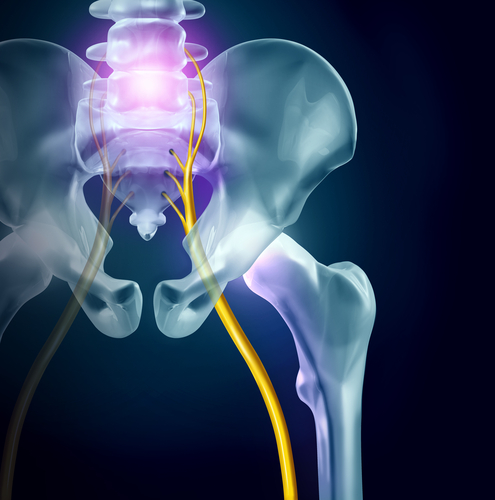Sciatica is one of the most debilitating conditions anyone can experience. It can also be one of the more complicated conditions anyone can experience because of the extreme pain involved.
What is sciatica?
Sciatica most often arises from a pinched nerve in the lower lumbar spine, or the low back. This is significant because the sciatic nerve is formed by the L4, L5, S1, S2, and S3 nerve roots. These five nerves merge together into the sciatic nerve, which passes underneath the piriformis muscle. The piriformis is found beneath the gluteus maximus, and when it tightens, it can compress, or pinch, the sciatic nerve. This is a significant issue for pregnant people. More on this later.
As the sciatic nerve travels down the back of the thigh, it passes underneath the long head of the biceps femoris, one of the hamstring muscles. It branches out into various other nerves, including the tibial and common fibular (peroneal) nerves just before reaching the back of the knee. These nerves then branch out into the rest of the leg and foot.
True sciatica is often felt from the low back and pelvic area, down one of the legs, all the way to the toes. It can range from a deep throbbing ache to sharp lightning down one of the legs. It’s nearly impossible to get any relief from sciatica, no matter what position you get into.
A pinched sciatic nerve can arise from a herniated (bulging) or ruptured disc. If it’s the latter, surgery may be needed.
Intervetebral discs are mostly made up of a gel-like fluid called the nucleus pulposus that is encased by a fibrous outer ring called the annulus fibrosis. When one vertebra is unevenly stacked upon the vertebra below, the imbalanced positioning will place more pressure on side of the disc than the other. A water balloon is a good example to understand this concept. If you hold the water balloon in your hand and squeeze, it will bubble out one side of your hand or the other. This is what a misaligned vertebra does to the disc.
Add in years of improper movement (like repetitive bending over, twisting, or leaning at the waist to pick up heavy items) and improper posture (slouching on the couch to watch TV or hunched in front of the computer), and the integrity of the spine becomes severely compromised. Then, vertebral misalignments become the rule, not the exception. This eventually leads to conditions like osteoarthritis, degenerative disc disease, and bulging or ruptured discs.
 But where do spinal misalignments come from?
But where do spinal misalignments come from?
Trauma and injury are obvious reasons, and don’t need much explanation. Car accidents, sports injuries, slips, falls, even sneezing! (Yes, I once had a patient who gave herself sciatica from sneezing.)
Emotional stress can do very weird things to our body, including weakening the systems in our body. Whether it’s the immune system (weakening the body’s ability to stave off sickness), the cardiovascular system (emotional stress, particularly anger, can cause arteries to weaken and clog, as well as increase blood pressure and pulse), or the muscular system (taut & tender muscles and muscle spasms).
A sedentary lifestyle almost always play a part in sciatica, as I touched on above. We’ve all heard the old adage that “movement is life.” That’s because it’s the 100% truth. Less than 24 hours after surgery, knee and hip replacement patients are helped up out of bed to begin walking again. So, if you spend half or more than half of your day sitting slouched in front of a computer or a desk, it’s time to rethink the ergonomic setup of your work space before your spine pays too much of a price.
If you’re wondering why sitting for long periods of time can be so detrimental to the spine, here’s why: The spine has a natural C-shaped curve in our necks and low backs and less dramatic curve going the opposite way in our upper back. When we sit at a desk all day, slouched and hunched over, we reverse the curves in our neck and low back and we increase the curve in our mid back / upper back. This is problematic because it causes all of our extensor muscles on the posterior side of our body to stretch and tighten for extended periods of time, weakening them; and our flexor muscles on the front side of our body become severely under-activated, atrophying from the lack of movement, stretching, or resistance needed to maintain good muscular health. This does no favors for anyone or anything—except for gravity, which is always pulling us down into an even more imbalanced posture.
You can verify what I’m saying for yourself by looking straight up while simultaneously jutting forth your chin as if to give yourself a severe underbite. This will stretch the muscles on the front of your neck, from your chin to your clavicle (collarbone). Feel how tight that is? That’s because you’re probably spending too much time looking down at a phone or a computer screen. That’s not a judgement, it’s reality. Chiropractors are as guilty of this as anyone, I assure you.
The problem is that when we look down at a phone for too long, it tightens up and stretches the muscles in the back of the neck, particularly at the top of the neck / base of the skull. The largest percentage of mechanoreceptors in the entire body exists in this group of muscles called the suboccipital triangle, or SOT. The SOT muscles connect directly to the base of the skull, C1, and C2. Tension headaches, neck pain, and even vertigo can arise from a dysfunction of these muscles.
And of course, there is pregnancy. Remember earlier how I mentioned a tight piriformis muscle can compress the sciatic nerve and pose a problem during pregnancy? This can happen during pregnancy because of the widening of the pelvic bones to prepare for the baby’s arrival. Tight muscles in the rear end come with the territory during pregnancy, but an imbalanced spine resulting from vertebral misalignments (there are always spinal misalignments during pregnancy as the mother’s body changes, repositions, and prepares for a massive physical event) will exacerbate that gluteal muscle tightness. And pregnant women don’t need any more painful aggravation than they’re already experiencing.
Sciatica is one of the most common conditions I see in my office, and it is not a condition to be trifled with. It is painful, it can be debilitating, and it is a sign that something is in disarray with your spinal health.
If you’re suffering, there is a strong chance that chiropractic can help.
More from the Harshē Chiropractic Blog by Dr. Brandon Harshe













